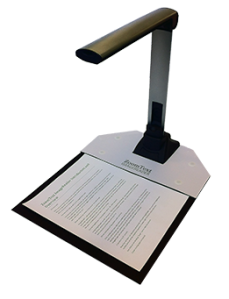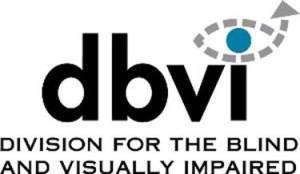The Tools Tab
| Final tab on the ZoomText tool bar is the Tools tab. |
| This tab has extra features and functionality that works with external devices |
Camera
| The ZoomText Camera feature allows you to use any high-definition (HD) webcam to magnify printed items and other objects right on your computer screen—including bills, magazines, photographs, medicine labels, craft items and more. Simple controls allow you to quickly zoom in and out and choose between full and high contrast colors1. If your computer does not have a webcam, you will not be able to utilize this feature. | |
| Full | Webcam mode takes up the entirety of screen. |
| Docked | Webcam mode takes up half of the screen. |
Listening
| Recorder | ZoomText Recorder allows you to turn text from documents, webpages, email or other sources into audio recordings that you can listen to on your computer or transfer to your mobile device for listening to on the go. You simply copy or select the text you want to record and start ZoomText Recorder. With a few simple steps you give your recording a friendly name, choose a destination to record to and click the record button. And each recording is created using your choice of ZoomText voices or any other voices available on your system1.
Copy text to the clipboard and then simply press the Recorder button or use the hotkey Caps Lock + Ctrl + C. Pressing the Recorder button will open the ZoomText Recorder menu. Record text to a file or directly into Windows Media Player. Use the Track Name text field to name your recording. If you’re recording your text as file, choose which file type you’d like to save it as. You can choose between wav (Waveform Audio File Format) or wma (Windows Media Player File Format). The Waveform Audio File type is more universal and will likely be compatible with a range of devices and applications. The Windows Media Player type is specifically for Windows Media Player and won’t be as compatible outside of that context. Choose the Track Location which is where in your computer’s memory the audio file will be saved. When you’re ready, hit the Record Text button to start your recording. The progress bar to the right will continue to fill with green, progressing from left to right, several times. Under Preview and Capture, listen to a preview of your capture with the Listen to Preview button. To the right, there is a text box that holds the underlying text of the capture. You can replace this text by adding text to the clipboard and hitting the Capture Keyboard button. Here you can review the underlying text of your recording to rerecord or make a new file. Select Show Synthesizer Settings to choose specific settings for your recording. Change the Synthesizer, Voice, Rate, Pitch, and Volume of your recording. |
| Background Reader (BgRdr) | Background Reader allows you to listen to documents, webpages, email or any text while you simultaneously perform other tasks. You simply copy or select the text you want to listen to and start Background Reader. While the text is being read aloud, you are free to type notes, browse the web or do other work on your computer1.
The Background Reader is similar to the Recorder – however, instead of creating an audio file out of your clipboard text, you simply play the clipboard text using ZoomText. Copy text to your clipboard and then press the Background Reader button or use the hotkey Caps Lock + C. Pressing the BgRdr button (or using the hotkey) will bring up the ZoomText Background Reader toolbar. Use the toolbar to play and pause the recording, restart the recording from the beginning, capture and start reading new text, and move through the text by sentence and word. The Background Reader uses a series of hotkeys (see below). |
|
|
|
| Start Background Recorder from clipboard text | Caps Lock + C |
| Start Background Recorder from selected text | Caps Lock + S |
| Play/ pause Background Reader | Caps Lock + Enter |
| Show Background Reader toolbar | Caps Lock + T |
| Restart Background Reader | Caps Lock + Backspace |
| Background Reader read current word | Caps Lock + Ctrl + Space |
| Background Reader read previous word | Caps Lock + Ctrl + Left Arrow |
| Background Reader read next word | Caps Lock + Ctrl + Right Arrow |
| Background Reader read current sentence | Caps Lock + Space |
| Background Reader read previous sentence | Caps Lock + Left Arrow |
| Background Reader read next sentence | Caps Lock + Right Arrow |
| Exit Background Reader | Caps Lock + Escape |
ImageReader (ImageRdr)
| This is ZoomText’s Ocular Character Recognition (OCR) feature. |
| To use this feature, you’ll need to purchase the ZoomText ImageReader camera. This is an external device that, at the time of writing this, costs $749.00. |
 |
| You can follow this link to find out more about the ZoomText ImageReader. |
Application Specific Settings
| In ZoomText, we can create sets of settings specific to each of our programs. For example, maybe you prefer higher magnification when using Microsoft Excel, you can set up application specific settings so each time you switch to Excel, your magnification automatically goes up! |
| You can have specific settings for all your applications! Settings will switch automatically as you |
| Customize your settings for the current application, then simply go to File and then Save Application Settings |
| To review and manage your application settings, go to File then Manage Application Settings. This will open the Manage Application Settings menu where you can enable, disable, or delete application settings. Select the Help button to read more about Application Settings in the ZoomText Help Guide. |
| Use Name Applications in the File menu to give applications “friendly” names that make more sense to you. For example, rename the Application “AcroRd32.exe” to “Adobe” or “Adobe Reader”. Creating friendly names for application will help you organize and manage application settings. |
References
| 1. AI Squared. (n.d.). Zoomtext 10 quick reference guide. Retrieved from AI Sqaured website: http://www.aisquared.com/docs/zt10/ZT10_QRG_US_English.pdf |


